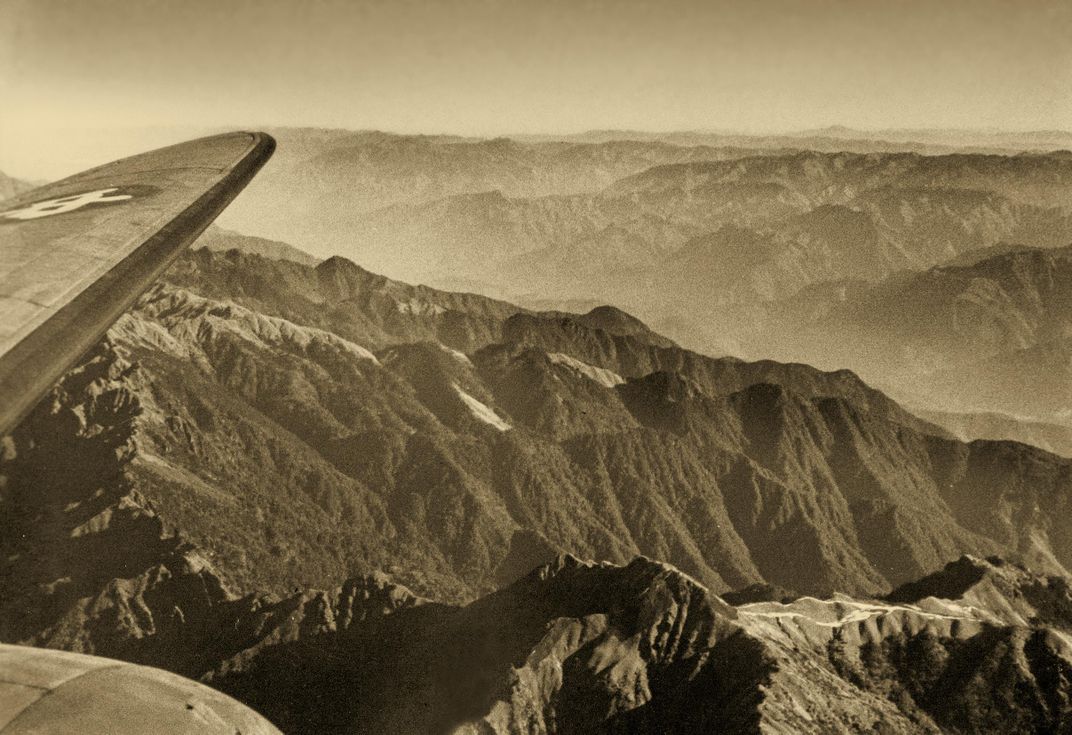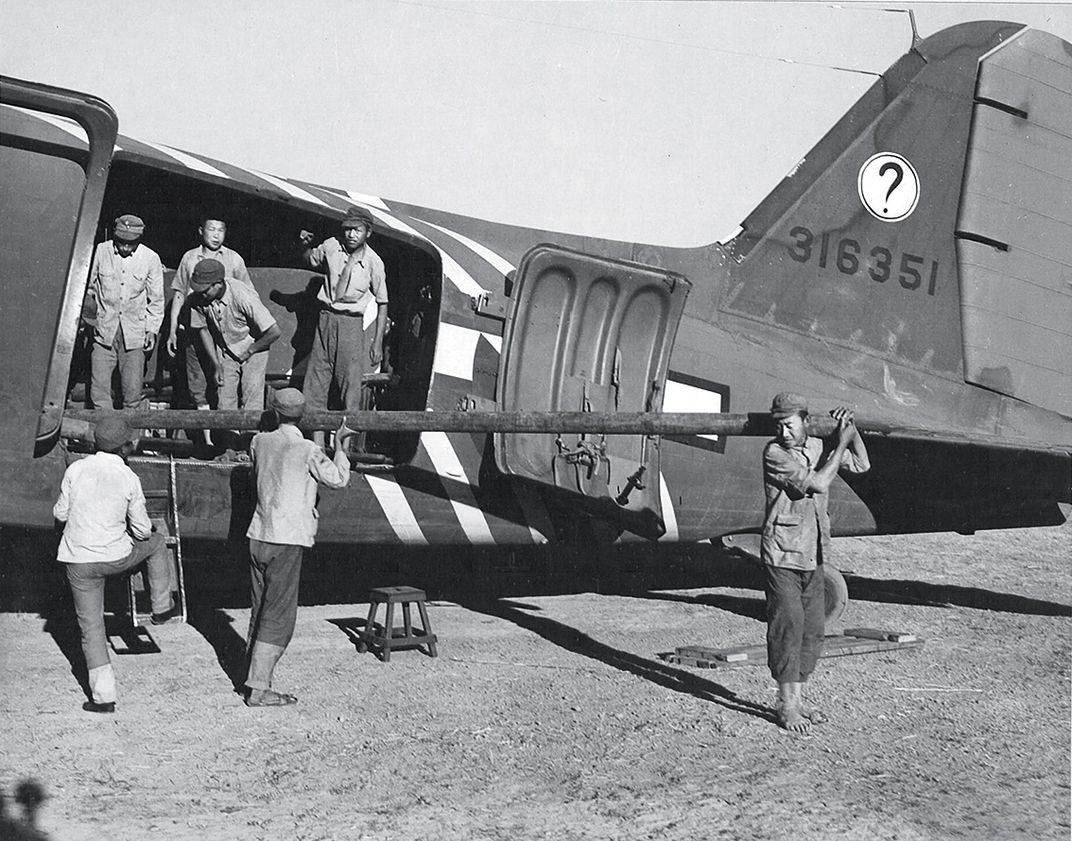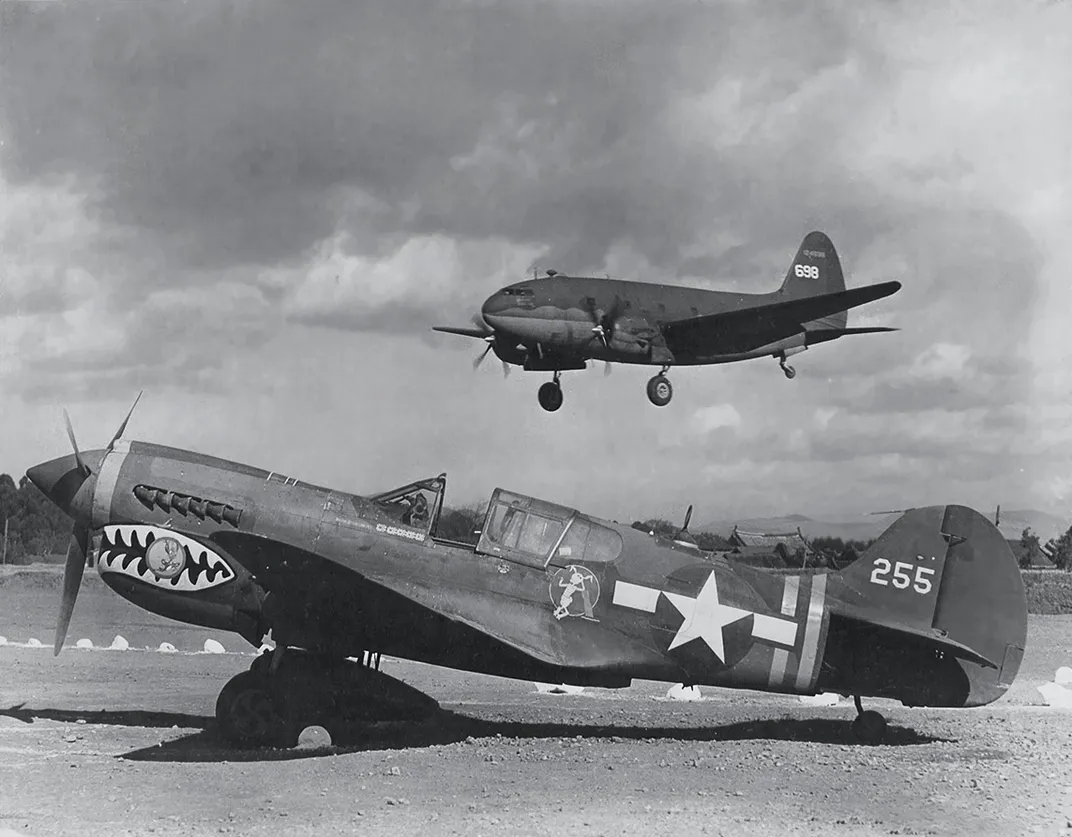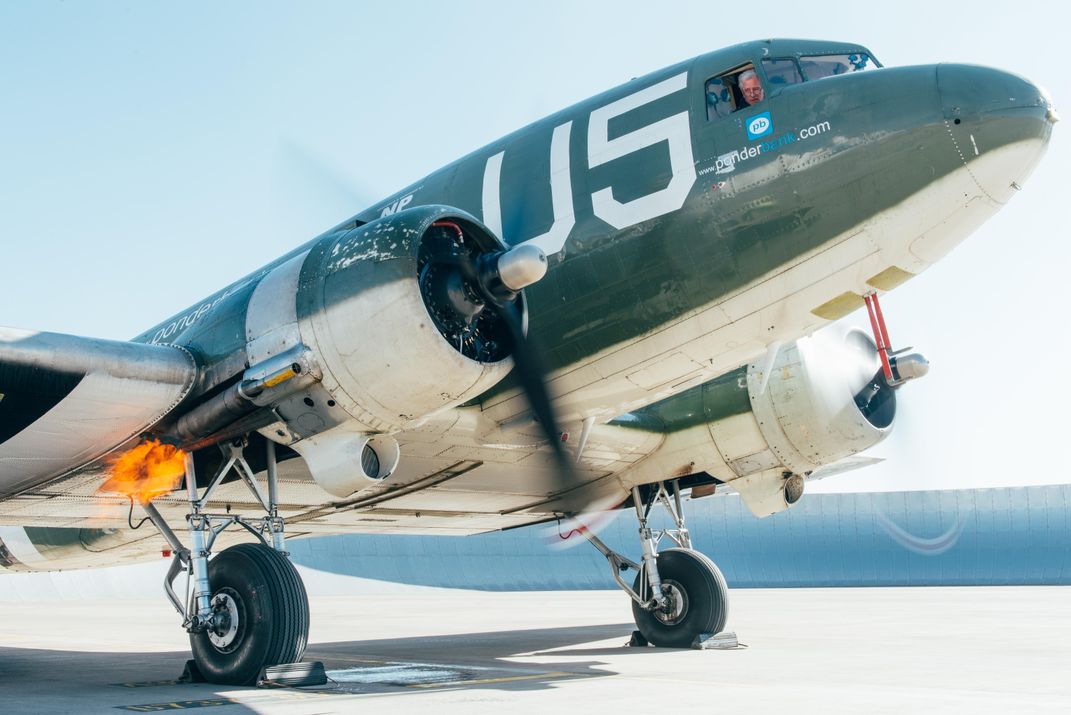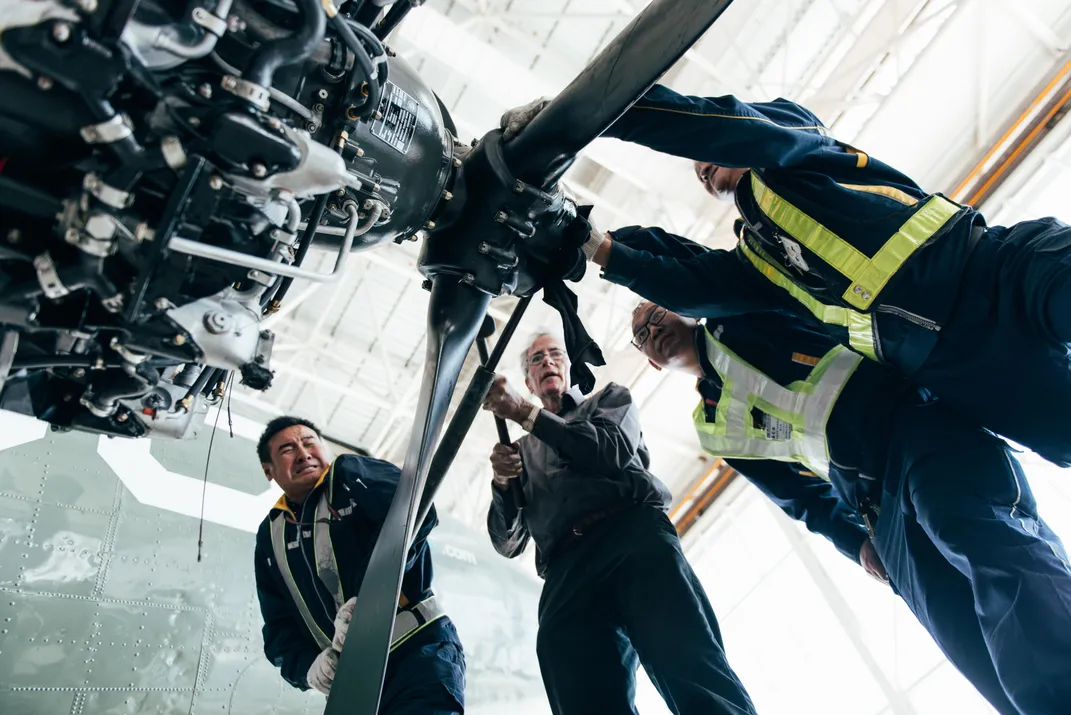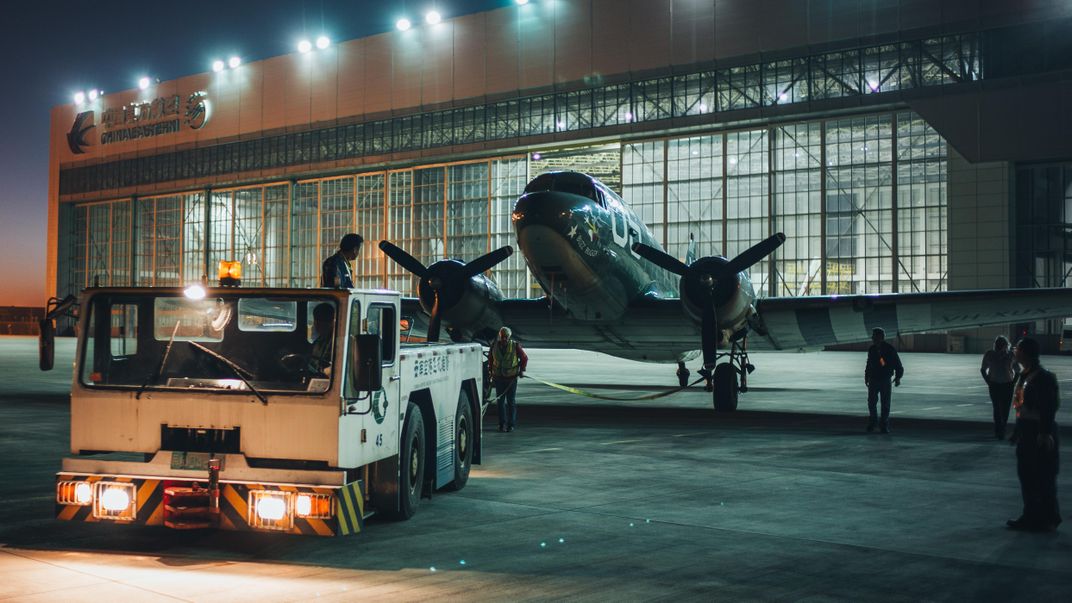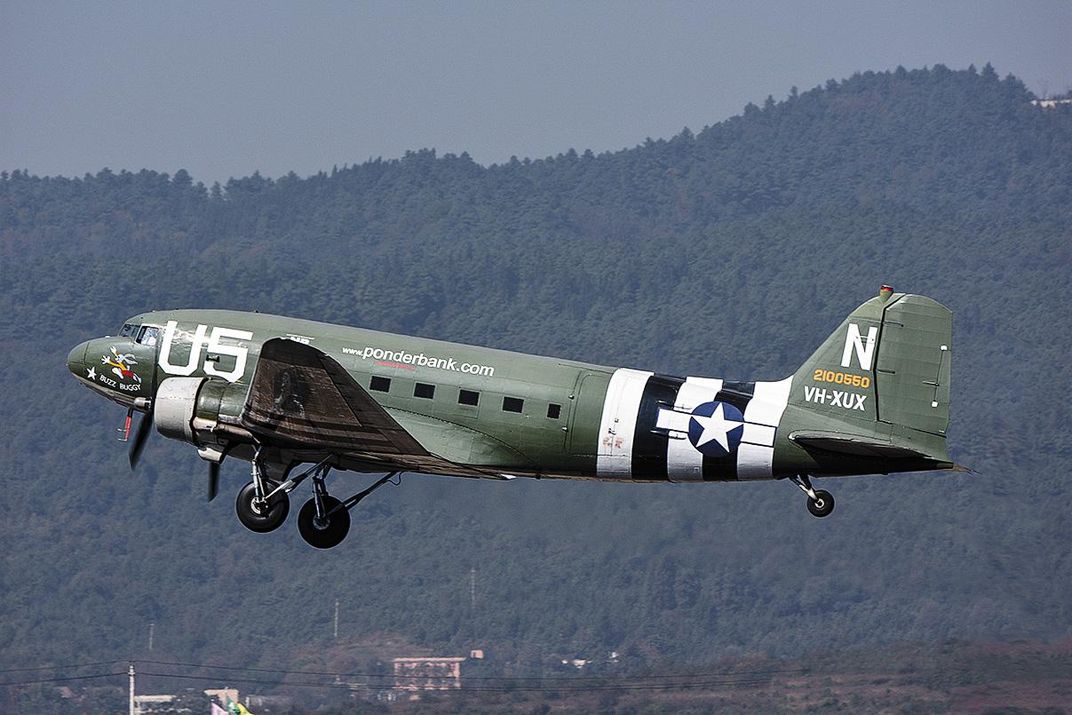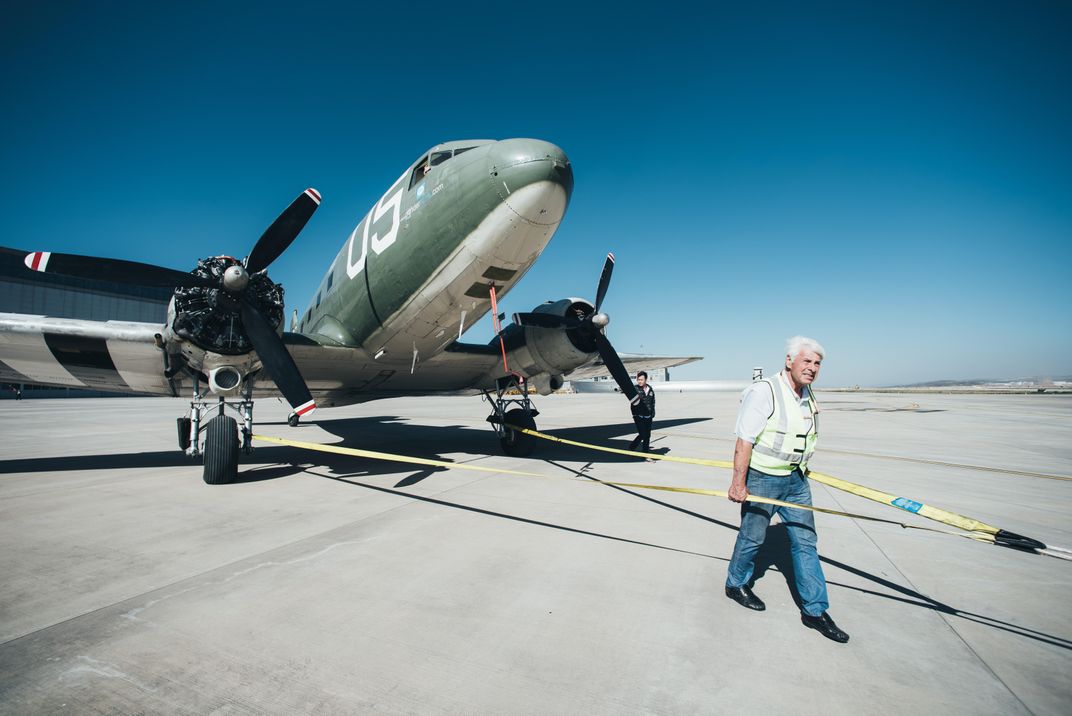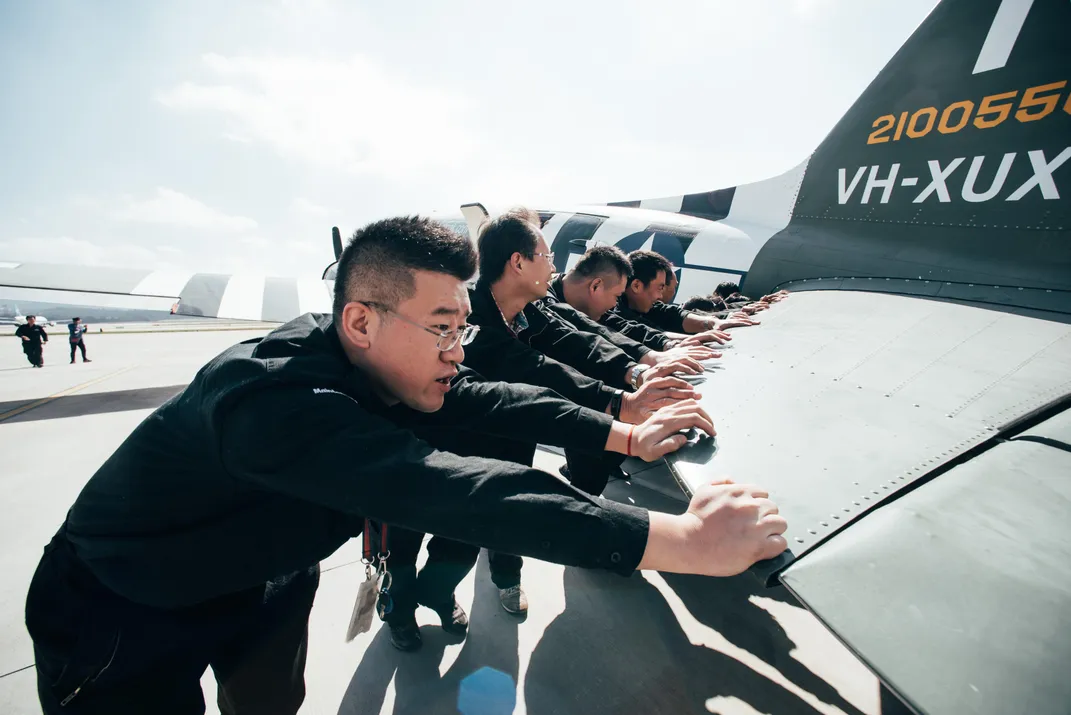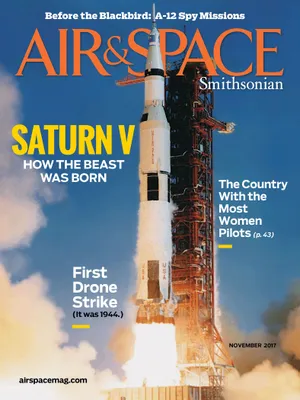A Celebration of U.S. WWII Pilots—in China
The last Douglas C-47 to fly “the Hump” is enshrined in a Chinese city park.
:focal(1555x3787:1556x3788)/https://tf-cmsv2-smithsonianmag-media.s3.amazonaws.com/filer/7b/3b/7b3bb9fb-0363-4e33-90f0-14fbeaab55bd/07b_on2017_buzzbuggyarrivalguilinnov19-2016_live.jpg)
Last March in Guilin, China, the symbol of a rare cooperation between China and the United States went on display at the Flying Tiger Heritage Park. The park occupies the site of a former airfield where in June 1942, General Claire Chennault set up a forward base for the American Volunteer Group—the Flying Tigers—revered by the Chinese for taking on the Japanese bully that had been pummeling them since 1937. The symbolic object now on display there is an airplane, but not a dashing, shark-mouthed P-40, the Flying Tigers fighter that bedeviled Japanese bombers. It’s a dumpy C-47 Skytrain, painted on one side with the star and bars of the U.S. Army Air Forces and on the other with the Chinese character representing the China National Aviation Corporation, an airline jointly owned in the 1930s and ’40s by the Chinese government and Pan American Airways. Had it not been for the C-47s and other supply aircraft flown by those organizations on a treacherous route across the Himalayas, the P-40s of the Flying Tigers wouldn’t have had the gas to fight. From November 1941 until the end of the war, the airline and the Army carried 650,000 tons of supplies into China. Without that air bridge, the country was virtually cut off from the Western world.
The memorial in Guilin was created by the Chinese people and the Flying Tiger Historical Organization, a U.S. group that raised money to help build the park and locate, restore, and deliver the C-47 for exhibition there. I heard about their project, which was fraught with almost as many difficulties, if not the same perils, as the original transport missions, through my participation in a group formed to remember the pilots and crews of the China National Aviation Corporation. In the missions to fortify China, they flew from Dinjan, India, in the Assam province, to Kunming, the Flying Tigers headquarters, a route that became known as the Hump. More than 1,300 people lost their lives. One of them was a young CNAC pilot from Winnetka, Illinois, whose C-47 crashed in the Chinese mountains only a year after the airline pioneered the passage. His name was James Sallee Browne, but I knew him as Jimmie. He was my cousin and, five years older than me, my idol.
/https://tf-cmsv2-smithsonianmag-media.s3.amazonaws.com/filer/47/e4/47e4a009-6821-4483-af9d-1f316a5a21f9/07e_on2017_chrisbull_c_47-014_live.jpg)
**********
Right out of high school, Jimmie had a private pilot’s license and a multi-engine rating. The Royal Canadian Air Force accepted him in 1941 and sent him to England, where, as a pilot with the Royal Air Force Air Transport Auxiliary, he ferried many types of aircraft to distant airfields around Great Britain. He was good-looking and wild—a little too wild for the ATA. After accidents in a Spitfire and a Hurricane, both labeled “pilot to blame,” he buzzed the ATA headquarters at RAF Ratcliffe and was sent back to Winnetka. By chance, a famous CNAC captain, Harold Sweet, was visiting Chicago in 1942 and met the Brownes. He invited Jimmie to try out for Pan Am. Later that year, Jimmie was sent to fly the Hump.
The flying there was much different from the ferrying he had done around reasonably flat Great Britain. In an article for a CNAC newsletter, director Arthur N. Young, one of 16 aboard the DC-3 that made the first flight over the Hump, described what he saw from the airplane window:
After passing through clouds we came out into clearer weather to see far ahead the huge ranges running north and south that separate the three great rivers, the Salween, Mekong and Yangtze…. Soon we were over the Salween, in a very deep gorge…at about 14,000. We turned north to fly for a while parallel with the snowy range and above the gorge. It was a grand sight, with the sides of the gorge so steep that much of it was in shadow even about 1:00 p.m. The river looked like a thin black ribbon, with occasional white streaks showing rapids.
Then we turned east again toward the Mekong, and as the weather was clear we could cross the range without going above 14,000 feet, though we had expected to go much higher. We flew past bare rocky heights with snow just outside the windows of the plane. In all directions we could see higher mountains, but at this point those in sight probably were not over about 18,000 feet. We found the Mekong valley broader and less wild appearing, but in all this country there was no sign of any inhabitants. A forced landing would have been just too bad for us.
That first flight took place just two weeks before the Japanese attack on Pearl Harbor.
On November 17, 1942, on one of his first China missions, Jimmie flew with Captain John J. Dean, a former AVG pilot credited with downing three Japanese aircraft and given partial credit for a fourth. They took a load of aviation gas, ammunition, and other supplies into Kunming on C-47 no. 60, one of the recent arrivals from the American Lend-Lease program. At Kunming, workers reloaded the airplane with tin ingots for the return trip to Dinjan, and the pilots took off. CNAC 60 didn’t make it back to India. The following day, Jimmie’s parents learned that he was missing, and six months later, the U.S. Department of State notified them that they had changed the status from “missing” to “presumed dead.” Since the 1990s, my wife and I have been searching for clues to the crash site, hoping to recover his remains.
**********
So many crashes marked the 550 miles of the Hump that by the end of the war, crews were calling it “the aluminum trail.” A book with the title The Aluminum Trail, self-published in 1989 by Chick Marrs Quinn, the widow of one of the pilots lost, records the details of 696 fatal crashes along the route. These are the sacrifices that retired Major General James T. Whitehead Jr. and former United Airlines captain Larry Jobe sought to honor when they formed the plan in 2013 to fly a C-47—or its civilian twin, a DC-3—once more across the Hump into Kunming for delivery to the Flying Tiger Heritage Park in Guilin.
Florence Fang, businesswoman, former publisher of the San Francisco Examiner, and chairwoman of the Independent Newspaper Group, donated $150,000 to purchase the aircraft—a C-47A named Buzz Buggy—from Australian Ralph Chrystall.
Buzz Buggy had been around. Completed on February 16, 1944, at the Douglas Aircraft plant in Oklahoma City, it served with the Royal Australian Air Force until 1949, when it was sold to MacRobertson Miller Airlines. Its civilian career included service with Ansett Airlines in Papua New Guinea, Air Tasmania, and Forestair. It was withdrawn from service in the 1980s.
Chrystall bought it at auction in 2015 for $31,000 dollars Australian (about $33,000 U.S.), and restoration was begun. On May 15, 2016 after the Flying Tiger organization acquired it, Buzz Buggy came before the Australian public at a Bathurst airshow. It still wore the D-Day invasion stripes that had been painted on for its role in the 1986 film Sky Pirates.
Flying Tiger Historical Organization president Larry Jobe oversaw the project to prepare the airplane for the flight from Australia to Myanmar (formerly Burma), and from Myanmar over the eastern edge of the Hump to Kunming. Tall and white-haired, with the bearing of an airline captain, Jobe had first visited China in the 1990s when he was flying for United Airlines. “Like most Americans who grew up during the cold war, I had preconceived ideas of what I would find,” he says. “But it was very different from what I expected.” He says he found friendly, helpful people who were extraordinarily grateful to the Americans who had helped them during World War II. Those Americans, says Jobe, “built a bridge of friendship that we can cross today.”
After Jobe retired from United, he began leading tours to China for American aviators and became fascinated with the Hump and the China-Burma-India campaign. He estimates he’s read more than 200 books about that area of World War II history. Jim Whitehead is also a history buff who says he’s been “surrounded by history.” The first African-American U-2 pilot, he had a cousin in the Tuskegee Airmen and an uncle who fought in World War I with the Hellfighters, one of the few U.S. black combat regiments of the war. When on a tour together in 2005, Whitehead and Jobe noticed commercial and industrial developments moving steadily toward the hallowed ground of Chennault’s command post in Guilin. On the spot, they hatched the plan to save the site and to educate people about the Hump airlift. Chinese officials approved the plan, and 99 percent of the $4 million cost for the park was provided by the Chinese communities there. Once the memorial park was under way, the two pilots decided it needed an airplane.
Through the C-47’s former owner, Ralph Chrystall, Jobe recruited a crew. “Speaking of international cooperation,” says Jobe, “this wouldn’t have happened without the Australians.”
Meanwhile, K.C. Ma, vice president of the organization and president of the Asia Holiday Travel Agency, went to China to brief the local government agencies and arrange for proper ceremonies at the Guilin park. He spent six months preparing China for this event and says the Chinese were enthusiastic about the project. He also says that preparing for the flight “was the most difficult mission I have ever had before in my entire life, not only because [it was] time-consuming, but also needed courage and the spirit of sacrifice. Weather and unpredicted mechanical problems on the way made the advanced flight time schedule impossible.”
On August 15, 2016, all was ready, and Buzz Buggy took off from Bathurst in New South Wales on a journey of more than 6,500 miles. Dale Mueller, an American with hundreds of hours in the DC-3, was at the controls. Co-captain Allan Searle had flown DC-3s for Qantas Airlines in Australia and New Guinea. Jobe had flown 747s for United, and without a DC-3 rating, he was not expected to fly, but he went along as adviser, mechanic, chronicler, and morale officer. Also on board was Barry Arlow, a mechanic and engineer from Victoria, Australia, who had answered the call from Chrystall to join the project.
They easily made the first stop: Longreach, Australia, 666 nautical miles away. The next leg got them to Darwin, just over 1,000 miles farther, where they were joined by another pilot, Tom Claytor. An American whose flying career took him to Thailand, he became an indispensable negotiator in the difficulties to come.
On the next day, they traveled the longest over-water distance and landed in Bali, Indonesia, relaxed and happy. But on August 18, after a normal takeoff, they heard a sudden, chest-rattling “Bang!” Smoke spewed, then fire broke out on the left engine. Mueller alerted the traffic controllers at Surabaya, Indonesia, that the C-47 was coming in and settled the airplane down on Surabaya’s main runway.
The aircraft needed a new engine, which would cost $60,000. In about seven weeks, Jobe raised $20,000 through a GoFundMe campaign. The organization raised the rest through donations from their members, friends and neighbors, and borrowed some money from the park fund. Barry Arlow and Alan Searle flew back to Australia, where Arlow acquired a rebuilt Pratt &Whitney R-1830 and had it shipped to Surabaya, where it took nine days to install.
The next episode of international cooperation involved 15 Russians, who were in Surabaya overhauling a Sukhoi regional jet. They stepped in to help the C-47 crew after the Surabaya airport officials were less than supportive of the reenactment. (“This is one of the most corrupt places it has ever been my displeasure to visit, and they were looking for anything that would make us pay them a bribe or ransom,” Jobe wrote home at the time.) The airport officials insisted that the ruined engine be carried away with Buzz Buggy, but loading a 2,000-pound hunk of metal into the belly of the C-47 was a tall order for a crew whose average age was more than 70. With the help of the Russians and their cranes, levers, and vodka, the aviators finally got the old radial engine aboard. The Russians, who had significantly lightened the mood, bid Buzz Buggy and crew a noisy farewell.
**********
They were now 50 days into a trip that had been planned to last eight. The delay kept Dale Mueller from making the rest of the flight; he had to return to commitments in the United States and was replaced by Bob Small, an Australian pilot recently retired from Qantas. The crew also added another Australian mechanic, Michael O’Grady. O’Grady was a perfect fit. Whereas Arlow was voluble and sometimes profane, O’Grady was quiet and calm.
So it was Captain Alan Searle who lifted Buzz Buggy off the Surabaya airstrip on October 8, to everyone’s relief. As they departed, the “new” engine sputtered and skipped, but they continued toward Singapore’s Seletar field, where the crew switched out a faulty magneto. The troubleshooting and repair ate up another five days, though the Republic of Singapore Flying Club and Jet Aviation were as generous as the Surabayans had been stingy. They flew on to U-Tapao and Chiang Mai, Thailand, and Mandalay, Myanmar. Finally, on October 15, Buzz Buggy took off from Mandalay and headed for Kunming, the last C-47 ever to fly the Hump. But 10 minutes before arrival, the second original engine blew, spewing oil. Searle shut it down and landed at Kunming on one engine.
After a grand welcome in Kunming, city officials, determined to have the airplane flown on to Guilin, procured a new engine from U.S. supplier Sun Air Parts, Inc., had it delivered to the Kunming airport’s China Eastern Airlines hangar, and recruited three Chinese mechanics to help install it. “The only manual we had was the one in my memory bank from years of experience,” Arlow said. With a communication system consisting principally of hand gestures, the Chinese, who had never worked on a “round engine,” caught on quickly. The three Kunming mechanics had known about the Flying Tigers all their lives and never believed they would see a C-47.
On November 19, more than three months after its departure from Bathurst, Buzz Buggy made its final landing, at Liangjang International Airport in Guilin, to a cheerful reception. Eventually, it will be housed in a new building that displays memorabilia from the China National Aviation Corporation and other U.S. participants in the Chinese war against Japan.
**********
The same year that Jobe and Whitehead visited Guilin and resolved to preserve Chennault’s command post, my wife and I met Clayton Kuhles, a mountaineer who founded MIA Recoveries, Inc, devoted to finding CNAC and U.S. Army Air Forces crash sites on the Hump. So far, Kuhles has located 22 of the sites. In 2011, armed with information from our many years of research and hard-won leads, he located the site where CNAC 60 struck the mountain. He reported his discovery to the U.S. defense department’s Joint POW/MIA Accounting Command that September. We hoped for their help in recovering the remains of the pilots and radio operator, but there has been little action in the years since.
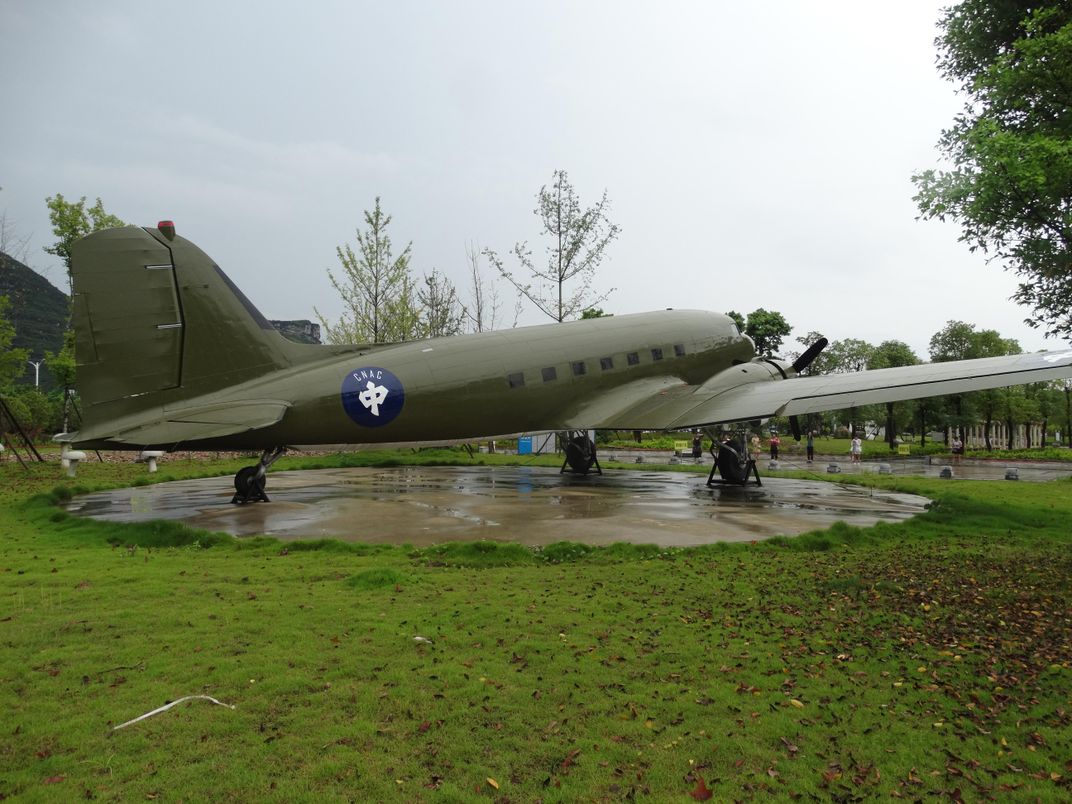
The crash site is on Cangshan Mountain, a range of up to 14,000-foot peaks above a picturesque lake in Dali, Yunnan Province. A promise made by the Chinese People’s Liberation Army to collaborate on a JPAC mission to investigate the site in 2015 was rescinded. The same year, the Chinese embassy in Washington, whose officials had been encouraging me, invited me to attend the Chinese celebration marking the 70th anniversary of the end of World War II. I took the opportunity to visit Dali, where a cable car carried me to a platform 9,400 feet above the valley. A group of about 20 residents joined me, my son, and our guides, and one of the women handed me a large bouquet of yellow flowers, for Jimmie and the crew. I placed the flowers in a vase that had been set on the cable car platform and lingered a few moments. My Chinese hosts stepped back respectfully as I stood there, and when I turned back, I saw few dry eyes.
In January 2016, the Chinese Minister of Foreign Affairs issued a ban on further efforts to reach the CNAC 60 crash site because of the elevation. He said that “at 13,000 feet, it was too dangerous to visit.” Kuhles, who has built relationships with the local villagers, is considering another expedition, but I think we’ve reached the end of the efforts to bring Jimmie home. The mountainside overlooking the ancient city of Dali and its peaceful lake might be fitting as a final resting place for the crew of CNAC 60.
For a marker, there is a monument in Kunming to all the Hump fliers, and now a lovely park in Guilin, graced by a 73-year-old C-47, that celebrates their contribution to the world. If it hadn’t been for crews like Jimmie’s, China could not have sustained its resistance, and the more than 1.2 million Japanese troops required to fight in China would have been unleashed on the Americans pushing across the Pacific. And the world today might be a very different place.
